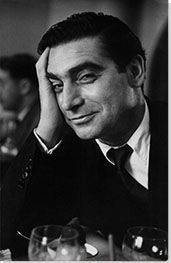Summary of Robert Capa
A war photographer that hated war, Capa used a small 35 MM camera to get close to the action and close to his subjects, thus he was able to show the devastating effects of violence on the lives of those in its midst. His approach to Photojournalism was rooted in the idea that photographs could tell stories, that single images could get to the essence of the subjects they captured, and thus his photographs of conflict were imbued with narrative and pathos. His iconic images of the Spanish Civil War and World War II are known today through their widespread reproduction on the printed page.
Through his work as a war correspondent, and the publication of his photographs in magazines and newspapers, Capa set the standard for future photographers and their collaboration with major news outlets.
Accomplishments
- Capa made use of the 35MM Leica camera. Small enough to be held in one hand, it was lightweight, and its 35MM film was compact and easy to use, allowing Capa to shoot roll after roll in quick succession. This meant that Capa could immerse himself in conflict zones around the globe and bring photography ever closer to the action. Thanks to photography's seemingly endless reproducibility, Capa's images were featured in magazines and newspapers around the world.
- Robert Capa had an early and abiding interest in journalism and its capacity for bringing current events to the attention of the public. He brought this interest to bear on his photography, often borrowing from journalism's tendency toward narrative accounts and storytelling, by focusing in on the plight of individuals. He believed that photojournalists should get as close as possible to their subjects in order to get to the heart of the story and re-humanize the often de-humanizing effects of war. As he later stated: "If your pictures aren't good enough, you're not close enough."
- Capa's work as a photographer and war correspondent was emblematic of a period that saw the rise of photojournalism and the ever-increasing demand for photographs by the mass media. Indeed, the necessity of providing images to newspapers and magazines ultimately led Capa and other famous photographers, including Henri Cartier-Bresson and David "Chim" Seymour, to band together to advocate for their own work and its publication. The result was Magnum Photos, a collective photography agency that was (and still is) run by its members (primarily photojournalists) and supplies images to news outlets around the world. Photographing important events in human history, Magnum's members have set the standard for professional photographers and photojournalists by controlling how, when, and where their images are used.
Important Art by Robert Capa
The Falling Soldier
In this iconic photograph a loyalist soldier is shown mere moments after being fatally shot. Isolated in a barren field, the soldier's body falls backward; his knees buckling and arms flailing. The rifle he was clutching in his right hand has begun to loosen from his grip. Full of movement and stillness, this grainy black and white image is emblematic of photography's singular ability to capture what photographer Henri Cartier-Bresson called the "decisive moment." Unflinchingly direct in its depiction of sudden death, Capa's photograph is now widely considered to be the most famous war photograph ever made.
The photograph's dramatic composition - of a soldier's outstretched arms near the moment of death - is reminiscent of Francisco Goya's The Third of May 1808 (1814), which illustrates another key moment in the history of modern Spain. This image, taken during the Spanish Civil War (1936-39), is from the first military campaign that Capa shot during his career as a war correspondent. The Falling Soldier is characteristic of his approach to photography and his uncanny ability to capture the most dramatic moments of war with startling realism. With this photograph Capa initiated a new form of photojournalism, which was made possible in part by the introduction of the handheld 35-mm Leica camera. The Leica allowed for maximum mobility and quick exposures, thus bringing photography onto the battlefield in a way had been impossible during World War I (when larger tripod-mounted cameras and glass plate negatives made instantaneous shooting untenable). The Falling Soldier brought Capa instant notoriety and, more importantly, it set the bar for war photography in the decades that followed. By 1938, at the age of twenty-five, Capa was hailed by the British magazine Picture Post, "the greatest war photographer in the world."
Controversial from the start, viewers were stunned by the photograph's violence when it first appeared in various European magazines, including Vu (1936), Paris-Soir (1937), and Regards (1937). Journalist Alex Kershaw has noted that when the image appeared in a 1937 Life magazine spread, "several readers wrote angrily to the editor complaining about such graphic depiction of violence. No such image had ever appeared in the homes of Middle America." In the ensuing years, further controversy has surrounded the authenticity of the photograph and whether or not it was staged for the camera. Some have claimed that the photograph was made during training exercises, rather than in the heat of battle, while others have disputed the location where the photograph was made. Kershaw reminds us that despite the controversy, "what has never been in doubt is that the publication of The Falling Soldier marked a point of no return. The photograph ensured..." that Robert Capa would be remembered as, "...the American photographer so daring, so determined to get as close as possible to the intensity of war, that he was even able to record the very instant of a man's death."
Gelatin Silver Print - Collection of Metropolitan Museum of Art, New York
Man carrying a wounded boy, Battle of Teruel, Spain
Here Capa focuses in on the face of a man who visibly struggles under the weight of the wounded child he carries in his arms. This close focus on the individual was a means of re-personalizing the war and its effects. Wearing a hat, with a cigarette dangling from his mouth, the man carries the young boy to safety in the aftermath of the siege of the Spanish hilltop town of Teruel. The young boy, whose left arm is slung across the man's chest, has been seriously injured, his right pant leg ripped open exposing his bare thigh and its blood-soaked bandage.
This photograph is one of a series of images Capa took while photographing the horrors of the Spanish Civil War. It is an excellent example of Capa's desire to show the devastating impact of war on everyday people in a way that the public could identify. According to journalist Alex Kershaw, through these important images, Capa sought to memorialize "the saddest faces of war," and "in so doing, he became the first photographer to bring the full horror of war into the homes of readers around Europe and beyond. In his images, the battle for Spain was pitiless, sparing none." For Capa, photographing the Spanish Civil War was about more than photographing the frontlines, it was also about telling the stories of those affected by it.
Gelatin Silver Print - Collection of International Center of Photography, New York
An American medic treats a captured German soldier, Sicily, July 1943
In this 1943 photograph by Robert Capa an American medic treats an injured German soldier recently captured by Allied forces. A closely cropped image, taken from the side, it shows a medic, wearing a helmet and white medical armband, as he treats a visibly bloodied German soldier. His eyes closed, the German soldier seems remarkably calm in the aftermath of a long and arduous battle that ended with his capture. This image is emblematic of Capa's ability, even in the face of unspeakable acts, to humanize his subjects and imbue his photographs with narrative and feeling.
Despite his relative fame as a war photographer, it was not until 1943 that he was officially sent to North Africa as a correspondent. Traveling with the U.S. Army, Capa followed the troops into battle first in North Africa and later in Sicily in the summer of 1943, where this photograph was taken. The sheer exhaustion of the German soldiers, who were captured after a week-long siege in the hills of Sicily, is palpable in Capa's photograph. Throughout his career as a photojournalist, Capa was committed to showing the harsh realities of war, from the heroism of the Allied soldiers, to the defeat and capture of the German forces. As journalist Alex Kershaw has written, "Capa's photographs expressed better than words the awful truth of the Italian campaign."
Gelatin Silver Print - Collection of International Center of Photography, New York
US troops' first assault on Omaha Beach during the D-Day landings. Normandy, France, June 6, 1944
In this famous war photograph, Robert Capa captured the American soldiers' first assault on Omaha Beach during the D-Day landings. In the foreground, a young soldier crawls ashore with his gun at the ready. Slightly out of focus, in grainy black and white, we are just able to make out the soldier's determined face. Other indeterminate forms emerge from the murky water. The focus here is the single American soldier and his fight to stay alive. Capa, who was embedded with the American troops at the time, jumped from the boat and while dodging bullets from German soldiers positioned on land, he turned to photograph the American soldiers as they made way on to Omaha Beach. Of that day he later stated, "my beautiful France looked sordid and uninviting [but] a German machine gun, spitting bullets around the barrage, fully spoiled my return. I saw men falling and I had to push past their bodies, which I did politely."
In his photographs of the D-Day landings Capa succeeded in capturing some of the most important and iconic moments of World War II. This image, in particular, demonstrates Capa's tenacity as a war photographer. According to his then photo editor at Life magazine, John Morris, "in order to take that photo Capa had to get ahead of that soldier and turn his back on the action. It was quite remarkable and an indicator of Capa's courage. I think that photo stands out because it humanizes the invasion. There is a single man walking ashore."
Now identified as private first class, Huston "Hu" Riley, 16th Regiment, Company F, the soldier in Capa's photograph landed on shore and was shot as he tried to outrun the gunfire. Riley later said that he was saved by "a buck sergeant... and a photographer with a camera around his neck... All I could think of was, 'What in the hell is this guy doing here?'"
This image is indicative of Capa's work and his desire to capture, "...a cut of the whole event which will show more of the real truth of the affair to someone who was not there than the whole scene." It is said that Capa took a total of four rolls of film on D-Day, the 6th June 1944, which he carried himself to London and sent by courier to his editors at Life magazine. Whether by some unfortunate darkroom accident or by other means, only eleven images from a single roll of film survived ("the magnificent eleven"). The film from the other photographers on Omaha Beach that day were all destroyed, making Capa's photographs, "the only complete photographic record of the worst hours of the invasion."
Gelatin Silver Print - Collection of Magnum Photos
American soldier killed by a German sniper, Leipzig, Germany
Taken in the final days of World War II, this photograph captured the death of an American soldier just seconds after he was shot by a German sniper. The young soldier had been standing on the balcony with a machine gun at the ready. Caught unaware by a hidden sniper, his lifeless body has fallen backward over the threshold, a pool of blood near his head. Stunned by the sniper fire, a soldier looks out over the railing to determine the source of the bullets; while two other soldiers crouch for cover in the apartment's interior room. American soldier killed by a German sniper is among Capa's most poignant photographs of the war, demonstrating photography's uncanny ability to capture these dramatic and singular moments on film.
Often erroneously referred to as "the last man to die" in World War II, the photograph of 21-year-old Raymond J. Bowman was among the last photographs Capa made in April 1945, just weeks before the end of the war. On the day this photograph was taken thousands of Nazi Germans surrendered to allied forces. At the time, Capa was traveling with the US 2nd Infantry Division. To take the photograph, he climbed through a balcony window and positioned himself in the room as the American soldiers manned a heavy machine gun above the streets of Leipzig.
By this time, Capa had spent four years covering the War for various news outlets. He spoke of the importance of this image during a 1947 radio interview: "I got in a nice bourgeois apartment where there was a nice young man on the balcony - a young sergeant who was [setting up] a heavy machine-gun. I took a picture of him. But, God, the war was over. Who wanted to see one more picture of somebody shooting? We had been doing that same picture now for four years [...]. But he looked so clean-cut like it was the first day of the war and he was very earnest. So I said, 'All right, this will be my last picture of the war.' And I put my camera up and took a portrait shot of him and while I shot my portrait of him he was killed by a sniper. It was a very clean and somehow a very beautiful death, and I think that's what I remember most from this war."
Gelatin Silver Print - Collection of International Center of Photography, New York
Pablo Picasso and Françoise Gilot, Golfe-Juan, France
In this lighthearted photograph by Robert Capa, the legendary Pablo Picasso is shown walking along the beach carrying a large umbrella to shade his young lover Françoise Gilot from the sun. Smiling broadly, the twenty-six-year-old Gilot strides confidently toward the camera in her long flowing dress and straw hat, while a smiling Picasso follows behind with an umbrella that is better suited to providing seaside shade than carrying like a parasol. In the background, the procession is completed with Picasso's nephew Javier Vilato. A masterful composition, the photograph was taken from a low vantage point, which makes the three figures appear in descending scale, from Gilot in the foreground to Picasso's nephew in middle ground.
While Capa is best known for his war photographs, his portrait of Picasso and Gilot is an important example of the artist's lighter side. Capa had a lively social life, surrounding himself with a circle of talented and famous friends, including Picasso. He spent several days photographing the couple and their one-year-old son Claude in August 1948, while on assignment in the south of France for the British magazine Illustrated. As Gilot later recalled, "We were clowning... Capa was a friend, so it was not formal at all. He took the picture in the spirit of the moment."
Like Picasso, Gilot was a talented painter. Despite her skill, Picasso told her at their first meeting that "Girls who look like you could never be painters." The couple had met in France during the occupation, before Picasso had officially separated from his wife Olga Khokhlova. They had a tumultuous ten-year affair and had two children together before Gilot left him. She later moved to the United States where she married Dr. Jonas Salk, who pioneered the polio vaccine.
Silver Gelatin Print - Collection of International Center of Photography, New York
Immigrant families wait to be assigned a tent at the transit camp Shaar Alyjah, Israel
In this black and white photograph, a group of men, women, and children - some seated, some standing - are shown with their belongings, shielding themselves from the heat of the sun. Captured unaware, the newly-arrived immigrants wait to speak to an unseen individual at the table to the right. From the man in the overcoat and hat to the seated women in the foreground, Capa alluded to the diversity of people that came to the newly formed state of Israel in search of a better life.
Taken in the years between 1949 and 1951, this photograph is one of a series of images shot during Capa's time in Israel. Over the course of several trips, he photographed the founding of the state on May 14, 1948, the first Arab-Israeli conflict, and the vast influx of refugees and immigrants in the two years that followed. "Israel," Capa once stated, "is the crudest and hardest place one can inhabit today. But it is a place where one hears the young people sing at night, and even the old ones talk about the bright future now awaiting them."
Here, as in other images, Capa humanizes his subjects by focusing in on the very real struggles that met the newly-arrived refugees. Having fled persecution himself at the start of WWII, he empathized with the plight of the Jewish people who found themselves caught up once again in historical events, events over which they had little control. As the above photograph makes clear, many refugees were forced to spend time in transit camps before they could be resettled in their new home. Capa later described them as "the 'people of the barbed wire' who have passed through scores of concentration camps in the last decade, reach the land of their dreams, only to be back once more behind barbed wire." It was through photographs, such as this one, that Capa tried to bring global attention to this injustice.
Gelatin Silver Print - Collection of International Center of Photography, New York
Biography of Robert Capa
Childhood and Education
Robert Capa was born Endre Friedmann into a working-class Jewish family. His parents, Dezsö Friedmann and Julianna Berkovits, ran a dress salon in Pest, Hungary where his father worked as a tailor. His brother Kornel was born five years later.
Capa had a relatively happy childhood and while he did not excel in school, he made friends easily and had an affable charm. As a teenager, he fell in with a group of student activists. Although he was not politically active, his affiliation with the group brought him to the attention of the Hungarian police, who later hauled him in for questioning regarding his presumed Communist sympathies. While in custody, he was beaten by interrogators, but they ultimately let him go when they found nothing for which to convict him. It is believed that a wealthy and connected client of his father's arranged his release on the condition that Capa immediately leave Hungary.
Early Training
At just seventeen-years-old Capa was forced into exile. In 1931 he arrived in Berlin and quickly applied for, and received, a scholarship to begin his studies in political science at the Deutsche Hochschule Für Politik. Before long, he had grown bored with his classes and was struggling to pay for his food and lodgings. His parents were no longer able to send him money and it was necessary for him to find a way to support himself financially. Despite his interest in journalism, he turned instead to photography as a means of steady income. Explaining the decision Capa stated, "while pursuing my studies my parents' means gave out, and I decided to become a photographer, which was the nearest thing to journalism for anyone who found himself without a language." A friend introduced Capa to photographer Otto Umbehr (Umbo), who gave him work in his Dephot (Deutscher Photodienst) photography agency. Capa started as a darkroom assistant and quickly worked his way up, teaching himself to shoot with the agency's Leica cameras. By the summer of 1932 had left college to pursue a career as a photographer.
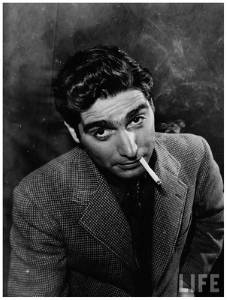
In November 1932 Capa received his first big assignment from Dephot to photograph a Leon Trotsky lecture in Copenhagen. The Trotsky images were part of a major magazine story that included his name with the photo credits for the first time. Although his assignments increased, he was forced to leave Berlin in 1933 with the rise of Hitler's Nazi party. He received permission to return to Hungary over the summer to visit his family, and several months later he settled in Paris.
Capa's first months in Paris were not easy. According to journalist Alex Kershaw, he was forced to sell his Leica camera for money on numerous occasions and even tried to fish in the Seine river for food. His luck eventually changed when he met photographer David "Chim" Seymour at a Paris café. Through Chim he was introduced to fellow photographer Henri Cartier-Bresson. The three men would become lifelong friends.
Still struggling to get work, Capa's fortunes began to change when his friend, and former colleague from Dephot, Simon Guttmann, arrived in France and helped him get his first major assignment since his move to Paris. The assignment took Capa to Spain, where he photographed boxer Paolino Uzcudun and hot-air balloonist Emilio Herrera.
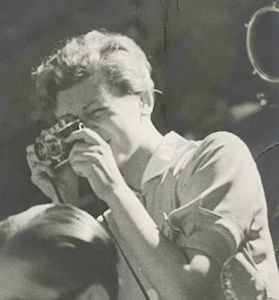
It was also at this time, in 1934, that Capa met Gerda Pohorylles (later Gerda Taro), a Swiss woman living in Paris. Like Capa, she had fled Germany the previous year when Hitler rose to power. The two quickly fell in love and began living and working together. Pohorylles played an important role in changing Capa's career trajectory. During her time at the international picture agency Alliance Photo, she began promoting his photographs as those of a mythical American figure named Bob Capa. She sold his images for three times that of the average European photographer by claiming that they were by a well-known American photographer who believed the French would pay too little for his work. Intrigued, agencies began buying his photos. Only when the ruse was discovered was he forced to come clean and permanently change his name to Robert Capa. Not long after, Gerda Pohorylles changed her last name to Taro. Capa's brother Kornel, also a photographer, followed his brother's lead and changed his name to Cornell Capa.
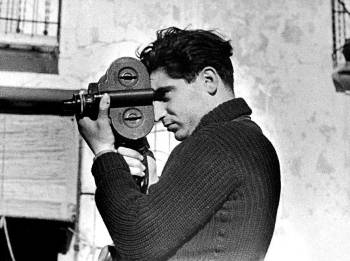
Following his name change, demand steadily increased for Capa's images. Working as a freelance photographer, he received numerous assignments in and around Paris. His first significant assignment as a war photographer came in 1936, when Lucien Vogel of Vu magazine sent him to cover the civil war raging in Spain. He went with Taro, and the two were in a plane crash but, remarkably, they were both unharmed. It was in Spain, in September 1936, that he took his famous photograph, The Falling Soldier. Of this time, Capa said, "no tricks are necessary to take pictures in Spain. You don't have to pose your camera. The pictures are there, and you just take them. The truth is the best picture, the best propaganda." His coverage of the Spanish Civil War led to a feature spread in Life magazine in November of 1936, thus initiating a long working relationship with the magazine.
![Statue “Freedom is not Free.” - Tribute to the Spanish civil war, in Netanya [Israel]. After the picture “Falling of Loyalist Soldier” by Robert Capa. The sculptor is Igal Tumarkin (2004)](/images20/photo/photo_capa_robert_4.jpg)
Although his time in Spain was a professional high point for Capa, it was also marked by personal tragedy. His partner Gerda Taro, who stayed behind in Spain while Capa traveled to Paris for work in July 1937, died when the car she was traveling in was struck by a tank. Widely considered to be the first female photojournalist to die while covering a war, Taro's death profoundly impacted Capa. Racked with grief, he never fully got over the loss and while he went on to have numerous relationships, he never married. Years later, when referring to Taro, he often called her his wife. According to Kershaw, "in Henri Cartier-Bresson's eyes, it was if a veil had been thrown over Capa. The man who eventually emerged from behind it was, as others saw him altogether different: cynical, ever more opportunistic, at times deeply nihilistic, afraid of attachment, permanently brokenhearted."
Mature Period
Having made a name for himself with his coverage of the war in Spain, Capa's career began to thrive. Beginning in early 1938, he spent six months in China filming a documentary about the Sino-Japanese War and then stayed to photograph the action, shooting the first ever war images in color. He then returned to Spain to cover the country's fall to General Franco. While in Spain he befriended writers Ernest Hemingway and Martha Gellhorn, who were both there on assignment. When Life magazine published a story about Hemingway's time in Spain, it included a series of photographs by Capa. By this time his work was widely popular and in December 1938 a photo spread of his images of war-torn Spain included the caption "The Greatest War-Photographer in the World: Robert Capa." Many years later, in 2007, a suitcase containing some 4500 negatives of the Spanish Civil War by Capa, Taro, and Chim, was discovered in Mexico. Assumed lost since 1939, the images and the story behind them were the subject of a documentary film, The Mexican Suitcase, and a traveling exhibition at the International Center of Photography (the museum founded by Robert Capa's brother Cornell).
In 1939, as World War II broke out across Europe, Capa fled persecution once again and travelled to New York City to visit his mother and brother who were now living there. Taking a job at Life magazine, he spent several months on assignment in Mexico covering their presidential elections. Nevertheless, Capa's hunger for action could not be quenched and he returned to England in 1941 to begin covering the war. He was sent to the front in March 1943 with the Allied forces in North Africa and later covered the fighting in Italy. He took many important photographs during the War, but none more famous than his image of the first group of American troops to come ashore in Normandy on D-Day. His final WWII images were taken when he parachuted with American troops to capture the German city of Leipzig.
The stress of the war and watching people die around him ultimately took its toll on Capa. In addition to a bout of malaria in Italy, he suffered from battle fatigue and depression. But, after years of covering the horrors of war, he was elated to cover the liberation of Paris with Ernest Hemingway. While in Paris, the two friends had a falling out over a picture Capa took when the author was thrown into a ditch during an accident. Hemingway felt that Capa should have retreated, but instead he stayed and took photos of the accident, which Hemingway took as an attempt to make him look like a fool. While they remained friends, they were never as close again after that incident.
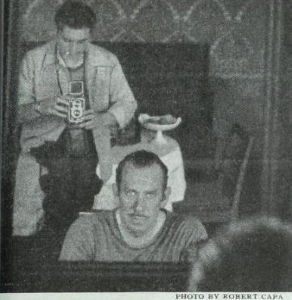
Despite the seriousness of Capa's work, he knew how to enjoy life and had a large group of celebrity friends. In addition to his friendship with Hemingway and Gellhorn, he spent time traveling with author John Steinbeck, hung out with director John Houston and actor Gene Kelley, and he knew Pablo Picasso and his family. He also had numerous affairs with beautiful women; most notably his years' long affair with the then-married Ingrid Bergman, who he met in Paris. Although they had to keep their relationship out of the public eye, he followed her to Hollywood in 1946 and became an American citizen. During this time he wrote his memoir Slightly Out of Focus: The Legendary Photojournalist's Illustrated Memoir of World War II, which he hoped (but never managed) to turn into a screenplay.
Later Period
After his brief stint in Hollywood, a place where he never felt entirely at home, Capa returned to Europe eager to get back to his work as a photojournalist. By this time, he and his cohort were tired of the ongoing exploitation of freelance photojournalists by large magazines. Capa and his friends sought to change the situation after his return to Paris. In 1947, working with Henri Cartier-Bresson, George Rodger, David "Chim" Seymour, and William Vandiver, he founded Magnum Photos, a cooperative photo agency, which allowed its members to maintain copyright of their own images. Regarding the creation of Magnum he later stated, "why be exploited by others? Let's exploit ourselves." Magnum Photos, which now includes nearly one hundred photographers from around the globe, is still in existence today and continues to promote Capa's work and legacy.
Capa's significant post-World War II assignments included covering Russia with John Steinbeck and a return to Israel to document the country's independence and the subsequent fighting that began in the days after. The photographs he took in Russia ultimately landed him in trouble with the government. Even worse, the money he made from selling his Russia photographs to Ladies' Home Journal drew the attention of the FBI. They had been keeping a file on him since the 1930s that questioned his links to Communism. The Russia photographs were enough, it seems, to merit further scrutiny. As a result, in 1953 his passport was suspended by the United States for several months, which limited his ability to work. He was later forced to make a formal statement to the FBI that he had never been a member of a Communist Party. His passport was eventually renewed with the restriction that he could no longer visit any "Iron Curtain countries." This unpleasant experience was exacerbated by his severe back pain and a brief hospitalization.
Capa's last major assignment began in April 1954 when he traveled to Japan to work for the Mainichi Press. While there he received an offer from Life magazine to fill in as a replacement photographer to cover the French war in Indo-China. Although he had grown tired of covering war and its atrocities, he accepted the assignment. While traveling with a convoy on the Red River Delta (Vietnam), Capa was killed by a landmine as he photographed soldiers advancing through a field. He was forty-years-old. In the end, Capa died as he spent much of his career: on the frontlines with his camera. As General René Cogny stated after his death, "Capa fell as a soldier among soldiers."
The Legacy of Robert Capa
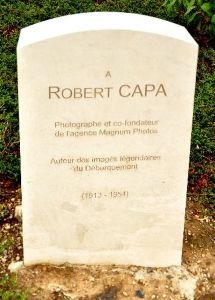
Robert Capa defined what it was to be a war photographer, laying the foundation for future generations of photojournalists working in the field. According to journalist Alex Kershaw, "Capa was the first photographer to make photojournalism appear glamorous and sexy." Not only was he among the first photographers to bring his camera onto the battlefield, he was also often embedded with the troops, traveling with them from one war zone to the next. His proximity to the stories he told through his photographs, succeeded in bringing the realities of war and conflict to the viewer with an immediacy that was previously unheard of. This proximity also, importantly, signaled the very real dangers of life as a war photographer. Part of what made Capa's images so powerful and visually engaging was his ability to humanize his subjects and tell something of their stories. It is this approach that has come to define photojournalism in the years since.
Another, equally important, aspect of Capa's legacy was the creation of Magnum Photos. Still thriving today, Magnum Photos, a collective photo agency that provides images to publications around the world, allowed freelance photographers to better control their images, how they are used, and the money made from them. At Magnum, Capa's legacy is still very much alive. His influence can be seen in the next generation of Magnum photographers, including Eve Arnold, Elliott Erwitt, Burt Glinn, Inge Morath, Marc Riboud, and such contemporary photographers as Susan Meiselas, Tim Hetherington, Philip Jones-Griffiths, Don McCullin, and James Nachtwey.
Influences and Connections

-
![Henri Cartier-Bresson]() Henri Cartier-Bresson
Henri Cartier-Bresson -
![Edward Steichen]() Edward Steichen
Edward Steichen ![David Seymour]() David Seymour
David Seymour- Pierre Gassmann
- Simon Guttmann
![Ernest Hemingway]() Ernest Hemingway
Ernest Hemingway- Martha Gellhorn
- Henry Luce
- John Morris
- Richard de Rochemont
-
![Henri Cartier-Bresson]() Henri Cartier-Bresson
Henri Cartier-Bresson - Eve Arnold
- Werner Bischof
- Burt Glinn
- Ernest Haas
![Ernest Hemingway]() Ernest Hemingway
Ernest Hemingway- Martha Gellhorn
- Henry Luce
- John Morris
- Richard de Rochemont
Useful Resources on Robert Capa
- Blood and Champagne: The Life and Times of Robert CapaOur PickBy Alex Kershaw
- Robert Capa: A BiographyOur PickBy Richard Whelan
